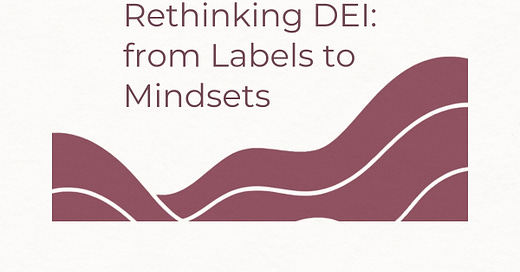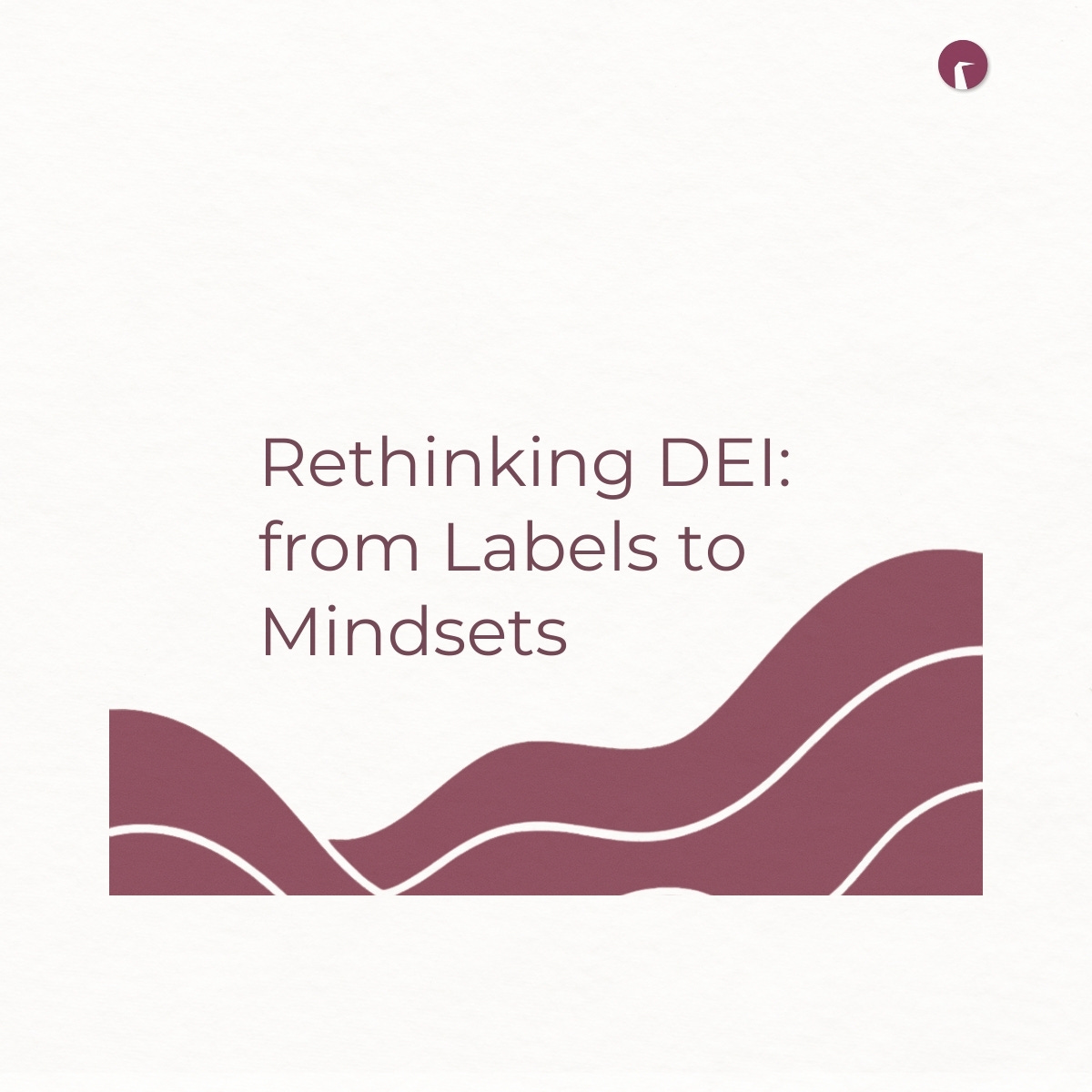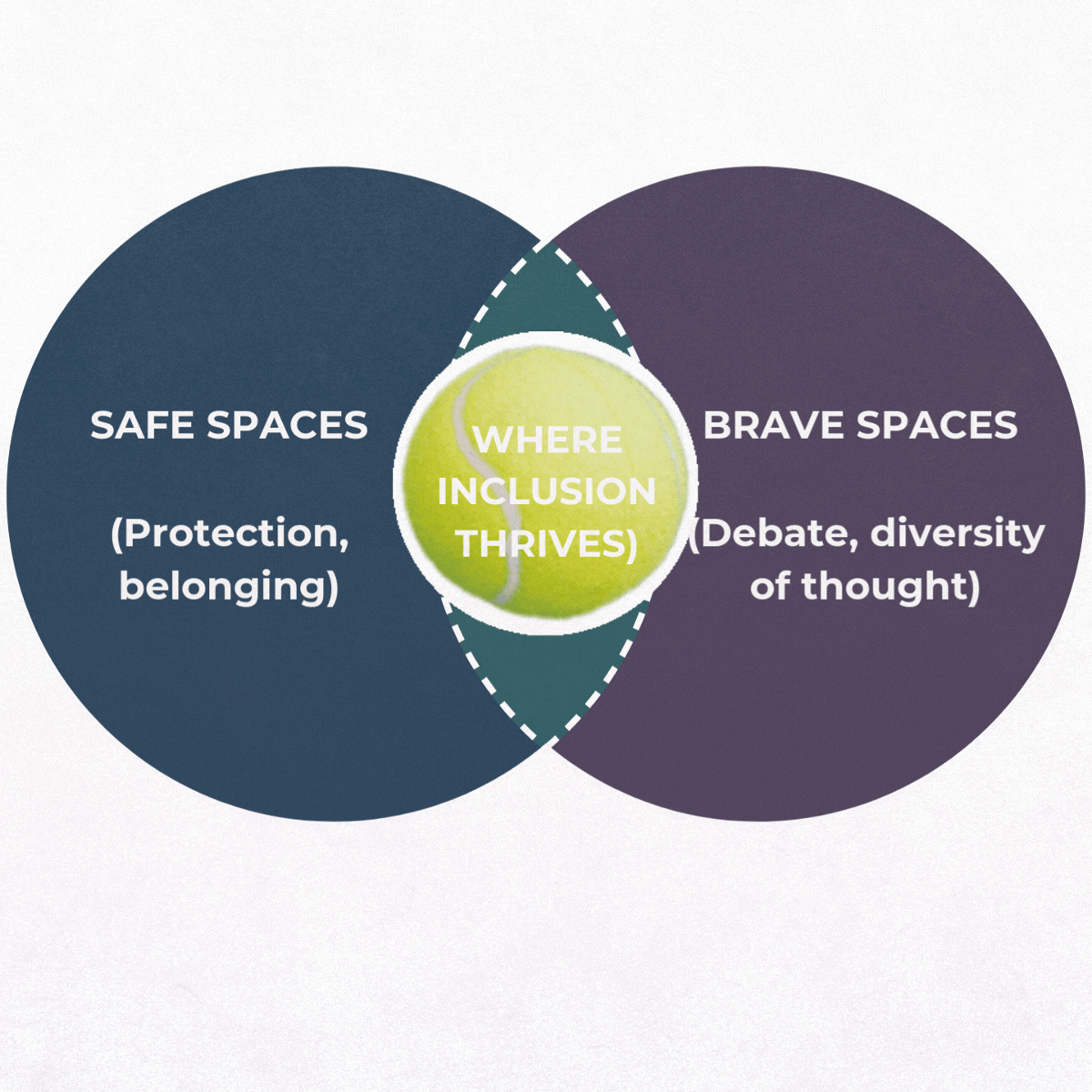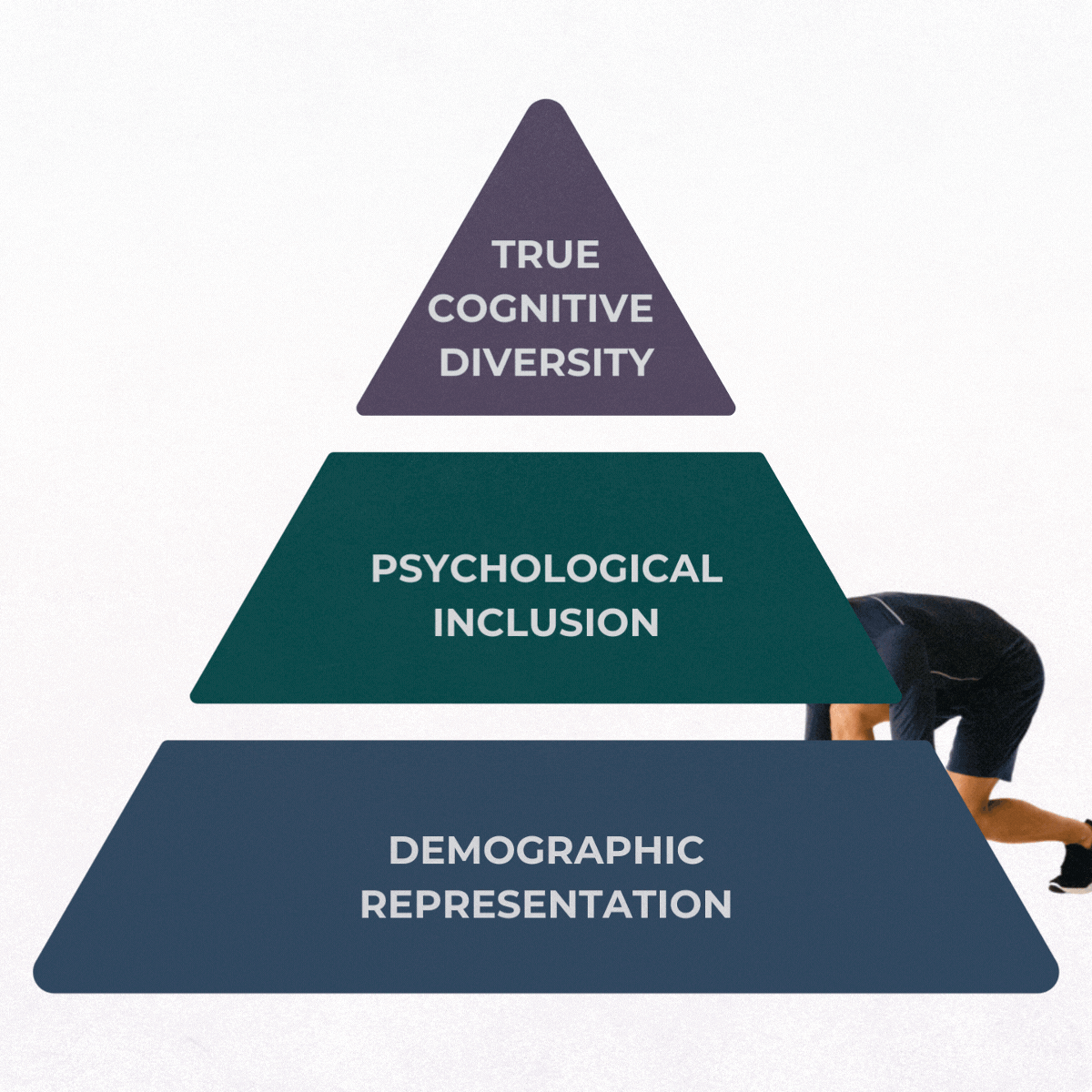A word cloud highlighting the terms "Equity, Diversity, Inclusion." DEI efforts often fixate on these labels, whereas a mindset shift emphasizes the human experience behind these terms.
……………………………
DEI work stands at a crossroads. After years of initiatives, trainings, and policies, many are questioning whether we've been too focused on labels and categories at the expense of deeper human connection.
Increasingly, there is a call to rethink DEI from a mindset perspective – one that emphasizes lived experience, personal growth, and genuine belonging over checkboxes and compliance.
✧ Authenticity over Labels
✧ Traditional DEI frameworks often classify people into neat identity categories – race, gender, ethnicity, and so on.
✧ While these categories can highlight underrepresented groups, they also create tension between personal identity and imposed social labels.
✧ Individuals are richly complex, often “made of many identities” that go beyond checkboxes for race or gender.
A person might simultaneously identify as a scientist, a mother, an immigrant, and an artist. Yet, structured programs sometimes reduce identity to a few broad categories.
✧ This shallow checkbox-style interpretation of identity assumes that a simple label tells us deep truths about a person’s mindset. It doesn’t.
✧ In reality, people navigate multiple, overlapping identities and often resist being flattened into one dimension.
✧ The pressure to fit into official categories can lead to a loss of authenticity. Some individuals even feel the need to hide or downplay parts of themselves to conform to workplace norms.
✧ Sociologist Erving Goffman and legal scholar Kenji Yoshino describe this as “covering,” or downplaying your identity to fit in at work.
For example, an employee from a minority background might mute cultural behaviors or opinions because they fear being seen only through the lens of that one identity.
✧ They face an internal conflict: be true to oneself or fit the mold that an organization’s DEI narrative has created.
✧ Over time, such covering can erode self-worth and stifle the very diversity of perspective that DEI is meant to celebrate.
✧ People want to bring their whole selves to work or school – not just the parts that match a sanctioned category.
✧ To move forward, we must embrace authenticity over labels. This means recognizing the fluidity and intersectionality of identity.
✧ All identities are, as feminist theorists note, social and cultural constructs that intersect in unique ways for each person.
✧ A one-size-fits-all approach to identity can inadvertently force people to choose which part of themselves “matters” most.
✧ Instead, rethinking DEI calls for spaces where a person can say, for instance, “I am both a teacher and a transgender woman and a first-generation college graduate,” without feeling like any one label defines her entirety.
✧ When people are invited to share their full stories, rather than tokenized as representatives of a category, it fosters a sense of dignity and belonging.
✧ The goal is to shift from labeling people to listening to people. By doing so, DEI work becomes less about what group someone belongs to and more about who they are as a unique human being.
✤ Safe Space or Echo Chamber?
✤ “Inclusion” sounds unambiguously positive – who wouldn’t want to be included? But the reality of building inclusive environments is paradoxical and complex.
✤ In recent years, organizations and campuses have created “safe spaces” intended to protect marginalized groups and encourage open sharing. These spaces can indeed offer support and understanding.
✤ Yet there’s a potential downside: a safe space can inadvertently become an echo chamber, enforcing an ideological conformity that actually excludes those with different viewpoints.
As one critic noted, “Inclusion now means creating a social environment where identity groups are celebrated while those who disagree are maligned.”
✤ In other words, a well-intended inclusion effort might silence alternative perspectives, labeling dissenters as insensitive or unwelcome.
✤ The very space meant to be “safe” for some can become unwelcoming to others who don’t 100% agree with the prevailing ideas.
✤ This paradox of inclusion raises tough questions. How do we ensure psychological safety for underrepresented people without turning away those with differing opinions or questions? It’s a delicate balance.
✤ On one hand, people from historically oppressed groups absolutely need spaces free from harassment and bigotry – places where they can speak openly about their experiences without fear.
✤ On the other hand, if inclusion requires absolute agreement with a particular ideology or language, it risks becoming what some have called “overprotective safetyism” or an orthodoxy.
✤ In such cases, intellectual diversity suffers and genuine dialogue shuts down.
✤ People may start to self-censor, afraid that one misstep will get them ostracized.
✤ In striving to include everyone, we must be careful not to create a culture where honest disagreement or evolution of thought is treated as heresy.
✤ A more nuanced approach is to cultivate “safe enough” spaces or even “brave spaces.” In a safe-enough space, individuals feel respected and heard, but not insulated from all challenge.
✤ There is room for discomfort as people grapple with new ideas. True inclusion should encourage respectful debate and growth, not require uniformity.
For example, a company’s DEI forum could welcome an employee’s thoughtful critique of a training program, rather than shaming them for speaking out.
Inclusion should be about expanding the circle, not drawing a tighter boundary around it.
✤ That means welcoming a diversity of perspectives — including those that question how we approach DEI itself.
✤ By doing so, inclusion lives up to its promise: creating an environment where anyone can belong, not only those who sing the same tune.
✢ Belonging and Autonomy
✢ At the heart of the human experience is a fundamental tension: the need to belong versus the need to be autonomous.
✢ Psychologists have long established that belonging (feeling connected to others) is a basic human need, as crucial to well-being as food or shelter.
✢ We all yearn to be part of a community where we are accepted. At the same time, we each have an inner drive to maintain our individual autonomy, to be true to our own values and make our own choices.
✢ This creates a tightrope walk: How do I fit in with a group without losing myself?
✢ As one observer put it, there is a tension in being human between the pull of autonomy – living life on my own – and belonging, since we are “creatures that crave deep connection.”
If I belong too much, I get swallowed up and lose my sense of self; if I isolate too much, I’m disconnected and lost.
✢ Many people feel this tension daily in workplaces and social groups, especially when DEI conversations are happening.
They ask: Do I have to adopt all the group’s views to belong here? Can I belong and still think for myself?
✢ The psychology of inclusion must account for this delicate balance. Internalized bias adds another layer to the struggle.
✢ Individuals from marginalized groups often wrestle not only with external prejudice but with internalized oppression, where they’ve unconsciously absorbed negative stereotypes about their own group.
For instance, a woman in tech might doubt her abilities because of a lifelong exposure to the idea that “tech is for men,” thus undermining her autonomy and confidence.
Internalized oppression is essentially when members of an oppressed group begin to believe and live out the negative messages directed at them.
✢ This can manifest as self-doubt, impostor syndrome, or even self-sabotage. People start to ask, “Do I really belong here, or am I just a token? Maybe I should just keep my head down.”
✢ Such thoughts erode both a sense of belonging (feeling that others value them) and autonomy (feeling personally empowered).
✢ To foster true inclusion, organizations need to address the inner work of DEI, not just the external metrics. This means helping individuals unlearn bias and build self-efficacy.
✢ Mentorship programs, affinity groups, or counseling services can provide support in navigating identity-related stress. It also means creating a culture that celebrates individuality within community.
For example, rather than expecting employees to all conform to a single corporate culture, progressive teams allow multiple subcultures to flourish. An employee shouldn’t feel that joining a company means erasing parts of themselves.
✢ Belonging and autonomy can reinforce each other when handled right: when I feel I belong, I have the confidence to be myself; and when I am true to myself, I contribute more authentically to the group.
✢ DEI efforts should thus focus on psychological safety that empowers authentic self-expression.
✢ Encouraging people to voice unique ideas (even if unpopular) and to share personal stories can signal that their presence matters more than their polish.
✢ The more individuals feel they can be their real selves and still belong, the more powerful and cohesive our communities can become.
✲ Innovating beyond the status Quo
✲ Many current DEI practices have grown stagnant, relying on the same check-the-box trainings and one-size-fits-all policies.
✲ To truly reinvent DEI, we must be willing to break the mold and experiment with unconventional, human-centered approaches.
✲ Activist and scholar Sara Ahmed famously noted that institutional diversity work often “serve[s] as ‘brick walls.’”
✲ She observed that doing the routine DEI work – drafting policies, hiring diversity officers – is “not the same thing as an institution willing to be transformed”.
✲ In other words, simply having DEI programs in place can give a false sense of progress while the deeper culture remains unchanged.
Rethinking DEI means pushing past these brick walls and seeking innovation that goes beyond the status quo. Here are some fresh strategies that prioritize lived experience, curiosity, and intellectual diversity over rigid rules:
➊
Center Lived Experiences through Storytelling
⍜ Facts and figures alone rarely change hearts. What resonates is story. Organizations can create forums (town halls, story circles, internal blogs) where people share personal experiences related to inclusion or exclusion.
⍜ Hearing a colleague talk about their journey – say, what it’s like to navigate the workplace as a single parent from a different culture – can spark empathy in ways that mandatory training slides never will.
⍜ Lived experiences are messy, nuanced, and deeply human; embracing them adds texture to DEI beyond sterile demographics.
➋
Encourage Curiosity Over Judgment:
▱ A culture of curiosity can dissolve the fear that often surrounds DEI conversations. Rather than walking on eggshells, employees and leaders alike should feel free to ask questions and learn from one another.
▱ Curiosity is a powerful antidote to bias – it leads us to genuinely understand perspectives different from our own. Research backs this up:
“By its very nature, curiosity opens the door to different points of view, facilitates insights and understanding, invites involvement and inspires greater engagement.”
▱ When people approach differences with curiosity instead of judgment, conversations become more open and less polarized.
For instance, instead of immediately criticizing a colleague’s unfamiliar viewpoint, a curious mindset might prompt you to say, “I’ve never heard it expressed that way – can you tell me more about what you mean?” Such dialogues transform DEI from a lecture into a learning exchange.
➌
Embrace Intellectual Diversity and Respectful Dissent:
◩ Diversity of thought is not a cop-out for avoiding tough topics, but a critical component of a truly inclusive environment. Welcoming unconventional or dissenting viewpoints (even within DEI discussions) can prevent the ideological lockstep that makes some initiatives stall.
◩ This doesn’t mean giving hate or prejudice a platform; it means recognizing that people of goodwill can disagree on methods and interpretations.
◩ A team might openly debate a new inclusion policy – perhaps someone voices concern that it could unintentionally create new exclusions. Instead of that person being labeled resistant, their perspective is examined and integrated if valid.
◩ Such “brave” conversations ensure that DEI efforts are robust, well-rounded, and have buy-in from many angles. In practice, encouraging debate and critical questions can lead to better solutions that a monolithic group might miss.
◩ Leaders should model openness to feedback, showing that inclusion includes them too – they are willing to listen and change course if needed.
➍
∆ Move from rigid policies to Human-Centric Design:
∆ Rethinking DEI means treating it as a continuous design process rather than a fixed rulebook.
∆ Rigid policies (like overly formalized language policing or quota systems) can backfire if they lack understanding of human psychology. Instead, organizations might borrow from design thinking – prototype, test, and iterate inclusion initiatives with input from employees.
For example, instead of a top-down mentorship assignment program, a company could pilot a “mutual mentorship” initiative where junior and senior staff are paired to learn from each other’s experiences (thus blurring traditional power lines and fostering empathy).
∆ If the pilot reveals problems, adjust and try again. The key is flexibility and co-creation: involve the people affected by DEI policies in designing those policies. This bottom-up approach values curiosity and feedback over rigid adherence to what “should” work.
The Future of DEI as a Catalyst for Human Flourishing
What’s the endgame for DEI? Too often, organizations treat diversity and inclusion as mere boxes to tick – a training here, a policy update there, and done. But the true promise of DEI is far more ambitious: it can become a catalyst for human flourishing.
Imagine a future where DEI is not an isolated initiative but an integral part of how we unlock human potential in every arena, from the workplace to education to community life.
In this vision, diversity and inclusion aren’t just about helping disadvantaged groups (though that remains crucial); they’re about enriching everyone’s experience and capabilities.
When diversity is genuinely embraced, it leads to a fertile mixing of ideas, perspectives, and talents that benefits all of society.
Studies have shown, for instance, that when teams truly value diverse voices, it turbocharges innovation – “Leaders who give diverse voices equal airtime are nearly twice as likely as others to unleash value-driving insights.”
In a flourishing-focused model, that statistic isn’t just about better business results; it’s about creating an environment where everyone’s insights can shine, leading to breakthroughs that make life better for all.
Reframing DEI as fuel for human flourishing means emphasizing growth, creativity, and well-being. Diversity is no longer a duty – it’s an opportunity. It challenges us to broaden our minds and break out of our comfort zones.
Culturally and philosophically, this hearkens to the idea that encountering difference is what helps us evolve.
Consider the African philosophy of Ubuntu, which holds that “a person is a person through other people” – often phrased as “I am because we are.”
This wisdom suggests that our individual growth and fulfillment are deeply interconnected with others. By engaging with people who are different from us, we actually expand our own humanity.
In practice, that could mean a company that actively rotates cross-functional teams to mix people from different backgrounds and skill sets, so everyone learns from each other’s strengths.
Or a university that incentivizes students to take courses outside their major, exposing science students to literature, for example, so they gain new lenses on the world. Such approaches rest on a belief that diversity isn’t a problem to manage, but a wellspring of possibility.
Moreover, an inclusive environment contributes to each person’s well-being. When you feel you truly belong and that your unique contributions are valued, it’s not just gratifying – it’s empowering.
People in inclusive settings often report higher engagement and even better health. It makes sense: if you’re not expending energy on hiding who you are or fighting for a seat at the table, you can devote that energy to thriving and excelling.
Equity, too, plays a role in flourishing, by striving to ensure that everyone has a fair chance to develop their talents. Equity asks: what supports or resources does each person need to succeed?
In a flourishing-centric DEI model, giving people what they need – be it mentorship, flexible schedules for caretakers, accessibility tools for the disabled, or leadership opportunities for those historically passed over – is seen as an investment in collective growth. The rising tide lifts all boats.
Finally, positioning DEI as central to human flourishing means embedding it into core values, not treating it as a separate silo. The future of DEI could see it intertwined with initiatives in innovation, well-being, and social impact.
For example, companies might link their diversity goals with their innovation pipeline: diverse project teams tackling big challenges like climate change or product design for global markets.
The idea is that inclusion drives excellence – when people feel free to express divergent ideas and bring their whole selves, the group can reach new heights of performance and creativity.
In communities, DEI could manifest as civic programs that bring neighbors together across cultural lines to solve local problems, strengthening social bonds in the process.
In all cases, the emphasis is on flourishing: measuring success not only by diversity numbers, but by outcomes like happiness, growth, resilience, and unity.
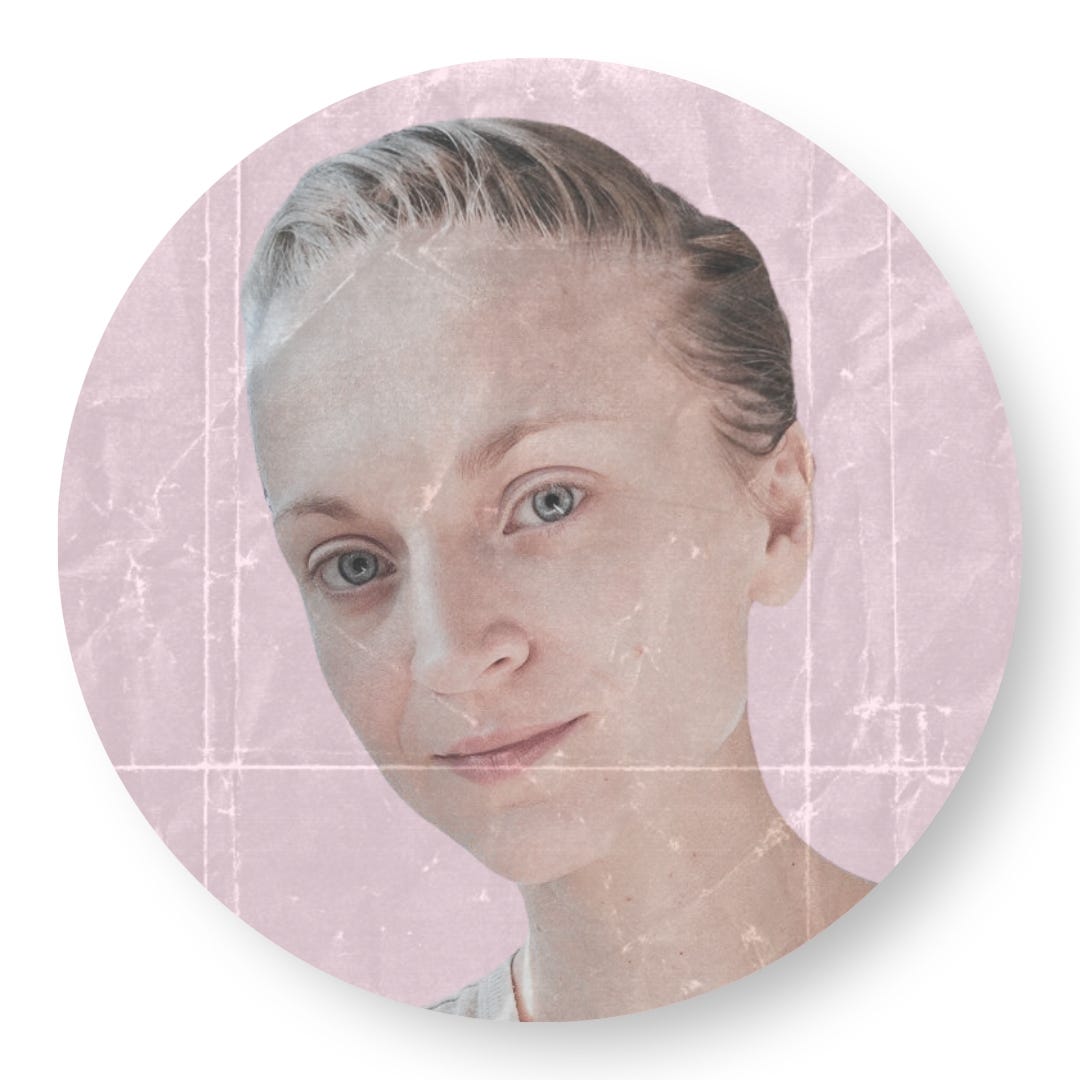
References:
Yoshino, K. (2006). Covering: The Hidden Assault on Our Civil Rights. Random House.Stanford Social Innovation Review. (2023). 'Checkbox Diversity' Must Be Left Behind for DEI Efforts to Succeed.
Crenshaw, K. (1989). Demarginalizing the Intersection of Race and Sex. University of Chicago Legal Forum.
The Fulcrum. (2023). It is Time to Rethink DEI.
Arao, B. & Clemens, K. (2013). From Safe Spaces to Brave Spaces. Stylus Publishing.
Haidt, J. & Lukianoff, G. (2018). The Coddling of the American Mind. Penguin Press.
Ryan, R. M., & Deci, E. L. (2000). Self-Determination Theory and Social Development. American Psychologist.
Freire, P. (1970). Pedagogy of the Oppressed. Continuum.
Wharton Knowledge. (2022). Why ‘Covering’ Can Harm Diversity in the Workplace.
Dobbin, F. & Kalev, A. (2016). Why Diversity Programs Fail. Harvard Business Review.
Ahmed, S. (2012). On Being Included: Racism and Diversity in Institutional Life. Duke University Press.

